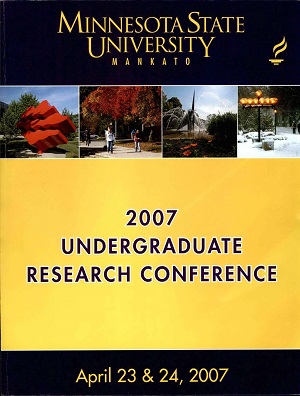The Effect of Chronic Exercise on Vascular and Kidney Responses in the Spontaneously Hypertensive and WKY Rat
Location
CSU 203
Start Date
24-4-2007 8:15 AM
End Date
24-4-2007 9:45 AM
Student's Major
Biological Sciences
Student's College
Science, Engineering and Technology
Mentor's Name
Penny Knoblich
Mentor's Department
Biological Sciences
Mentor's College
Science, Engineering and Technology
Description
Hypertension is among the leading causes of cardiovascular disease, with 65 million Americans suffering from the vascular disorder. Hypertension is believed to result, in part, from the kidney's failure to remove excess sodium and water from the body, as blood pressure rises. Regular exercise has been proven to reduce blood pressure in both humans and rats by reducing the development of atherosclerotic plaques, body weight, and resting heart rate, and alter hormone levels. The purpose of the study is to examine the effect of exercise on kidney sodium excretion in response to a rise in blood pressure. Thirty male and female SHR rats and thirty male and female WKY rats were randomly placed into one of the following groups: Exercise (given an exercise wheel from weaning to 12-14 weeks of age, or Sedentary (no exercise). Exercise time and running distance will be recorded daily. At 14-weeks of age, rats will be anesthetized (Inactin, lOOmg/ kg). A breathing tube will be placed in the trachea, and cannulas will be inserted into the carotid artery (to monitor blood pressure and heart rate), the jugular vein (to infuse saline to maintain fluid balance), and into the bladder for urine collection. After a baseline 15-niinute period which includes a urine collection, blood pressure will be artificially raised by tying off the celiac, mesenteric, and lower abdominal aorta. Blood pressure will be monitored and urine collected during 4 additional 15-minute periods. Urine will be analyzed for sodium excretion, and data will be compared between sedentary and exercise rats and amongst SHR and WKY strain rats.
The Effect of Chronic Exercise on Vascular and Kidney Responses in the Spontaneously Hypertensive and WKY Rat
CSU 203
Hypertension is among the leading causes of cardiovascular disease, with 65 million Americans suffering from the vascular disorder. Hypertension is believed to result, in part, from the kidney's failure to remove excess sodium and water from the body, as blood pressure rises. Regular exercise has been proven to reduce blood pressure in both humans and rats by reducing the development of atherosclerotic plaques, body weight, and resting heart rate, and alter hormone levels. The purpose of the study is to examine the effect of exercise on kidney sodium excretion in response to a rise in blood pressure. Thirty male and female SHR rats and thirty male and female WKY rats were randomly placed into one of the following groups: Exercise (given an exercise wheel from weaning to 12-14 weeks of age, or Sedentary (no exercise). Exercise time and running distance will be recorded daily. At 14-weeks of age, rats will be anesthetized (Inactin, lOOmg/ kg). A breathing tube will be placed in the trachea, and cannulas will be inserted into the carotid artery (to monitor blood pressure and heart rate), the jugular vein (to infuse saline to maintain fluid balance), and into the bladder for urine collection. After a baseline 15-niinute period which includes a urine collection, blood pressure will be artificially raised by tying off the celiac, mesenteric, and lower abdominal aorta. Blood pressure will be monitored and urine collected during 4 additional 15-minute periods. Urine will be analyzed for sodium excretion, and data will be compared between sedentary and exercise rats and amongst SHR and WKY strain rats.
Recommended Citation
Borg, Cassandra M.. "The Effect of Chronic Exercise on Vascular and Kidney Responses in the Spontaneously Hypertensive and WKY Rat." Undergraduate Research Symposium, Mankato, MN, April 24, 2007.
https://cornerstone.lib.mnsu.edu/urs/2007/oral-session-11/1



